A possible illustration seeking to relate OSINT to HUMINT particularly and other disciplines as well. Edit if needed please.
Dear Colleague,
You provided this illustration:
 This is an interesting depiction, from the perspective of a professional in India, in part because it reflects the traditional importance of HUMINT over the three technical disciplines (the Americans distinguish between GEOINT and IMINT as time when IMINT is being rapidly degraded by commercial options and GEOINT is not living up to its potential for lack of inter-disciplinary time and space tagging).
This is an interesting depiction, from the perspective of a professional in India, in part because it reflects the traditional importance of HUMINT over the three technical disciplines (the Americans distinguish between GEOINT and IMINT as time when IMINT is being rapidly degraded by commercial options and GEOINT is not living up to its potential for lack of inter-disciplinary time and space tagging).
Now after your helping me better understand the context in India and the shortfalls of our American system with unlimited funding for unproductive technology,, I recommend you adapt your model to the following:
 If you examine the Herring Triangle (Jan Herring was the first modern OSINT pioneer in US secret intelligence world, as the National Intelligence Officer for Science & Technology, or NIO S&T), you will intuit that OSINT — at very low cost — makes the existing clandestine HUMINT capability twice as productive, while narrowly focusing the technical capabilities that should always be in direct support of HUMINT, not running off on their own.
If you examine the Herring Triangle (Jan Herring was the first modern OSINT pioneer in US secret intelligence world, as the National Intelligence Officer for Science & Technology, or NIO S&T), you will intuit that OSINT — at very low cost — makes the existing clandestine HUMINT capability twice as productive, while narrowly focusing the technical capabilities that should always be in direct support of HUMINT, not running off on their own.
BACKGROUND INFORMATION
I would be very comfortable with the above depiction as a starting point but I encourage you to consider the below graphics as you contemplate three major questions:
01 Should intelligence be driven by REQUIREMENTS (what do ALL of our customers need to know) or COLLECTION (how can we justify ever increasing budgets by collecting shit we don't process hence that makes no difference)?
02 Should OSINT be what Joe Markowitz and Paul Wallner, in their most memorable contribution to the failed discipline, called “the source of first resort”? This was the conclusion the Dutch came to when Arno Reuser was the OSINT master for the Dutch military, he is still available to help India.
03 Has the time come to end the stove-piping of collection? Do we need to integrate all of the disciplines at the tactical, theater, national AND multi-national levels?
Never forget these two graphics which are very pro-military as a central management construct.

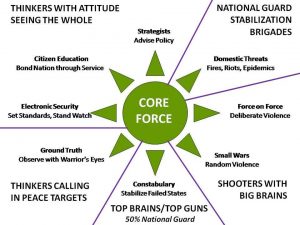
The military is the “natural” network within which to manage global to local intelligence and counterintelligence BUT the military is also a retarded organization in which the higher the rank the more clinically insane as well as oblivious the officer becomes — they confuse authority with integrity.
Consider:
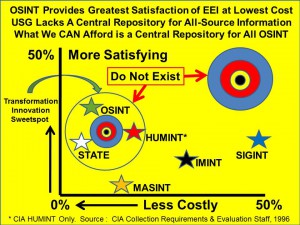
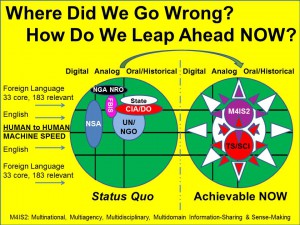
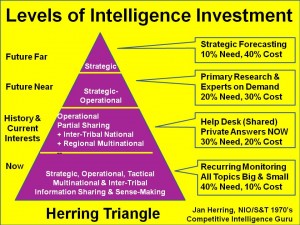
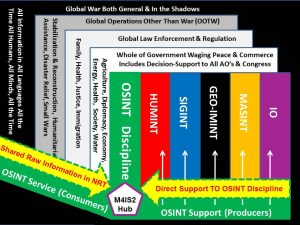
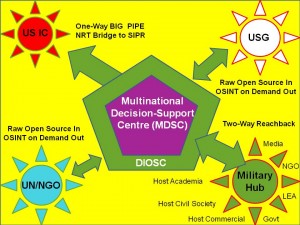
I have been pioneering in this area — with a holistic mind-set not to be found within the secret world, the Cabinet, or the White House, since 1988 officially, with holistic model development in my past back to 1974 (multinational home and host country issues), 1976 (pre-conditions of revolution), and 1987 (strategic mis-management of national security information).
I was very glad to have a tour in the Advanced Program and Evaluations Group in the Collection Requirements and Evaluations Staff (CRES/APEG) at CIA, and very sad when Sandra Cruzman (RIP) said of the below article to Ross Stapleton-Gray, “this confirms Steele's place on the lunatic fringe. She meant well but she did not know what she did not know — typical of secret “bosses.”
Steele, Robert. “E3i: Ethics, Ecology, Evolution, & Intelligence,” Whole Earth Review, Fall 1992, pp. 74-79.
It is worth noting that I understood all of this in 1988 from a military perspective, and that my boss in CRES/APEG, Boyd Sutton (RIP) ultimately agree with me by 1997. Here are core military oriented references.
2006 Sutton (US) Global Coverage, Looking Backward, Looking Forward
1997 Sutton (US) The Challenge of Global Coverage
Steele, Robert. “Intelligence Support for Expeditionary Planners,” Marine Corps Gazette, September 1991, pp. 73-79.
Steele, Robert. “Applying the ‘New Paradigm’: How to Avoid Strategic Intelligence Failures in the Future,” American Intelligence Journal, Autumn 1991, pp. 43-46.
Steele, Robert. “Intelligence in the 1990’s: Recasting National Security in a Changing World,” American Intelligence Journal, Summer/Fall 1990, pp. 29-36.
Gray, Al (Ghost-Written by Robert Steele), “Global Intelligence Challenges in the 1990’s,” American Intelligence Journal, Winter 1989-1990, pp. 37-41.
The people managing our national intelligence enterprise are corrupt and retarded and they like it that way because they are not held accountable for being virtual traitors, in constant betrayal of the President as well as the public.
Study the New Rules for the New Craft of Intelligence that I refined. They have been ignored since I formulated them in 2002 because no one holds all these entitled assholes accountable for being failures.
Steele, Robert. “New Rules for the New Craft of Intelligence,” in Robert David Steele, The New Craft of Intelligence: Personal, Public, & Political–Citizen’s Action Handbook for Fighting Terrorism, Genocide, Disease, Toxic Bombs, & Corruption, Oakton, VA: Open Source Solutions, Inc., 2002, Chapter 15, pp. 147-161.
New Rules for the New Craft of Intelligence
001 Decision-Support is the Raison D’être
002 Value-Added Comes from Analysis, Not Secret Sources
003 Global Coverage Matters More
004 Non-Traditional Threats Are of Paramount Importance
005 Intelligence without Translation is Ignorant
006 Source Balance Matters More
007 “Two Levels Down”
008 Processing Matters More, Becomes Core Competency
009 Cultural Intelligence is Fundamental
010 Geospatial and Time Tagging is Vital
011 Global Open Source Benchmarking
012 Counterintelligence Matters More
013 Cross-Fertilization Matters More
014 Decentralized Intelligence Matters More
015 Collaborative Work and Informal Communications Rise
016 New Value is in Content + Context + Speed
017 Collection Based on Gaps versus Priorities
018 Collection Doctrine Grows in Sophistication
019 Citizen “Intelligence Minutemen” are Vital
020 Production Based on Needs versus Capabilities
021 Strategic Intelligence Matters More
022 Budget Intelligence Is Mandatory
023 Public Intelligence Drives Public Policy
024 Analysts are Managers
025 New Measures of Merit
026 Multi-Lateral Burden-Sharing is Vital
OSINT is HUMINT.
OSINT/HUMINT are the foundation and the core for all-source INTEL.
The technical disciplines should be in SUPPORT of OSINT/HUMINT:
a. NSA should be providing tactical near real time SIGINT to clandestine operations overseas and counterintelligence operations at home, inclusive of 100% processing on traitors elite pedophiles, and white collar (Wall Street) criminals.
b) The All-Source Analyst should have an Open Source Agency (OSA) and global network of local to global subject matter experts on call as a starting point for addressing every requirement.
c) The secret disciplines should not be triggered on any challenge unless
c1) The OSA says it is falling short AND
c2) The customer certifies that the cost and risk of classified collection in warranted in the absence of an OSINT answer.
I no longer favor cutting the secret world in half. I now favor consolidating everything under a restored DCI, and redirecting one third to Global Coverage or Third World issues including the Arctic; and one third to domestic commercial and trade needs along with RUTHLESS counterintelligence against corrupt state and local officials bribed and blackmailed by the Deep State.
I continue to consider it vital to harness national intelligence toward the strategic goal of creating a Smart Nation. No one in Washington gives a shit about creating a Smart Nation that is prosperous for the 99% and at peace with the rest of the world, with the possible exception of Donald Trump and a few of this trusted people including Mike Flynn.
Just as you are thinking about how OSINT fits with the classified disciplines, you need to be thinking about how the military fits within Whole of Government and how Whole of Government fits within a Smart Nation, a World Brain, and restored localized self-governance for localized prosperity.
Steele, Robert. “Threats, Strategy, and Force Structure: An Alternative Paradigm for National Security,” in Steven Metz (ed.), Revising the Two MTW Force Shaping Paradigm, Carlisle, PA: Strategic Studies Institute, U.S. Army War College Press, 2001, Chapter 9, pp. 139-163. RDS BackUp PDF: SSI MET2 CH 9 THREATS STRATEGY
Steele, Robert. “Presidential Leadership and National Security Policy Making,” in Douglas T. Stuart (ed.), Organizing for National Security, Carlisle, PA: Strategic Studies Institute, U.S. Army War College Press, 2000, Chapter 12, pp. 245-282. RDS BackUp PDF: SSI STUART 12 PREZ LDR
Steele, Robert. “Creating a Smart Nation: Strategy, Policy, Intelligence, & Information,” in Alan Campen, Douglas Dearth, and R. Thomas Gooden (eds.), Cyberwar: Security, Strategy and Conflict in the Information Age, Fairfax, VA: Armed Forces Communications and Electronics Association, 1996, pp. 77-90.
Thank you for provoking me as you have.
SEE ALL
See Also:




